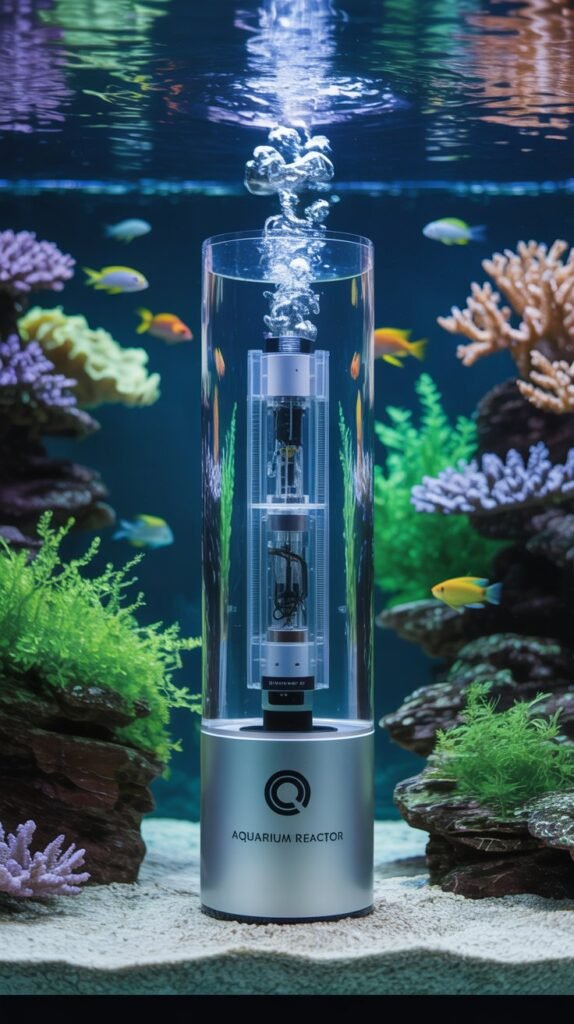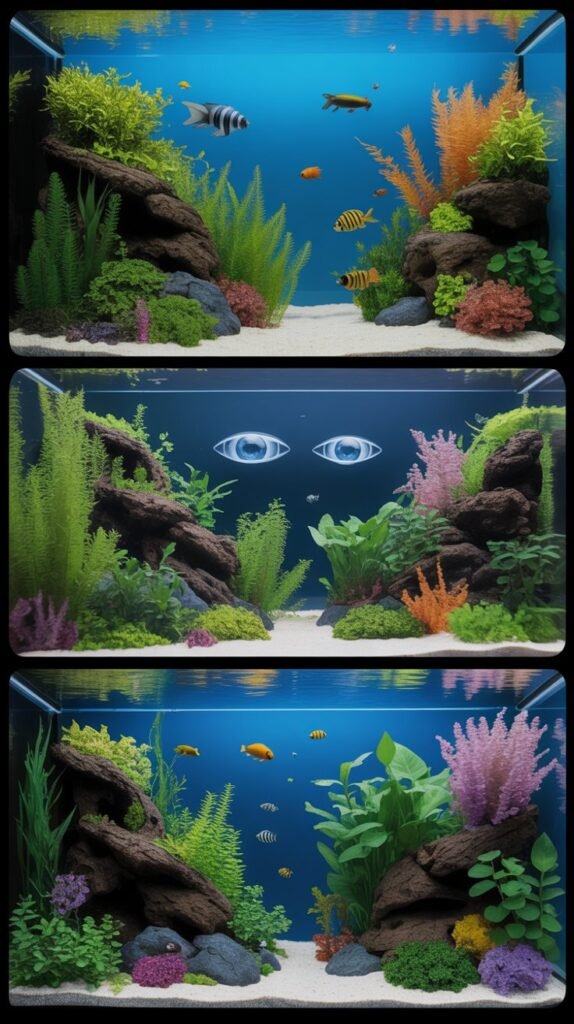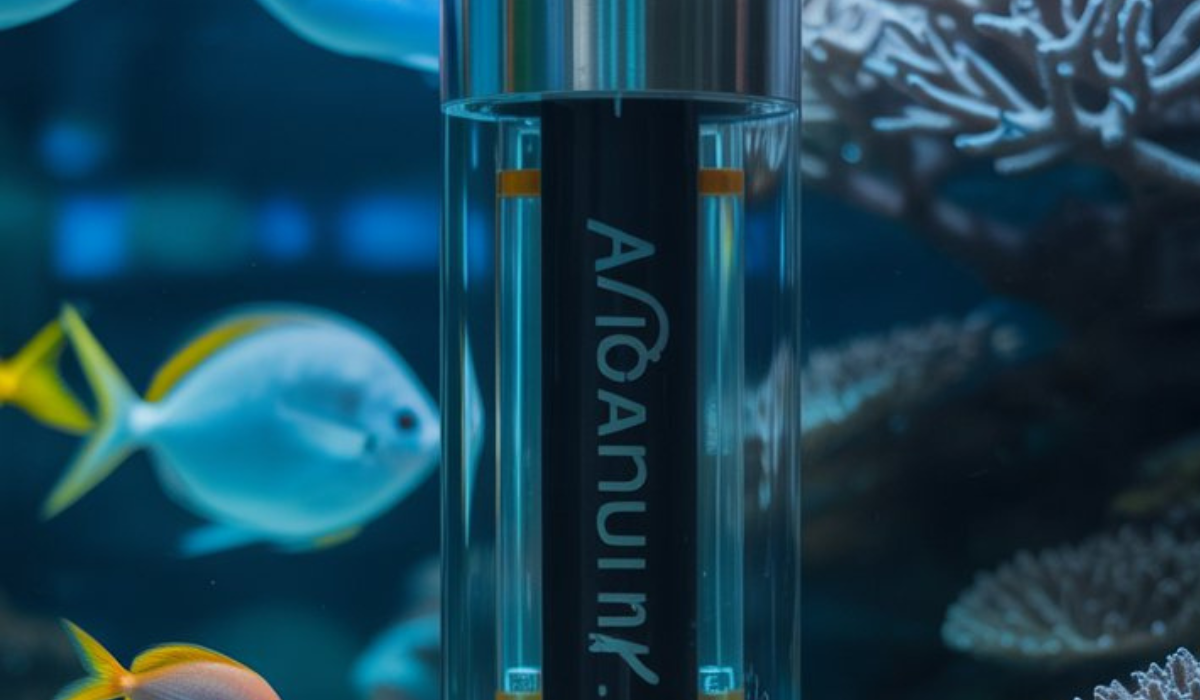Maintaining the right water chemistry is the foundation of a healthy aquarium. Whether you have a freshwater planted tank or a saltwater reef system, filtration and chemical balance play vital roles. One of the most powerful tools used by advanced aquarists to maintain these parameters is the aquarium reactor.
An aquarium reactor may look like a simple chamber, but it performs critical chemical and biological functions that improve water quality, reduce algae growth, and support coral or plant health.
In this comprehensive guide, we’ll explore everything you need to know about aquarium reactors — what they are, how they work, their different types, benefits, setup process, and maintenance.
1. What Is an Aquarium Reactor?
An aquarium reactor is a specialized filtration device that holds and circulates water through a specific reactive media, such as carbon, bio-pellets, GFO (granular ferric oxide), or CO₂. The reactor ensures that aquarium water passes evenly through the media for maximum chemical efficiency.

Instead of letting media sit loosely in a filter bag or sump chamber (where water might bypass it), a reactor forces water through it under controlled flow. This ensures consistent and thorough contact between the water and the media, improving overall filtration performance.
2. Purpose of an Aquarium Reactor
The main purpose of an aquarium reactor is to:
- Enhance water quality by efficiently removing impurities
- Maintain stable chemical parameters like pH, phosphate, nitrate, and calcium levels
- Support coral, plant, or bacterial growth
- Reduce maintenance frequency compared to traditional filter media setups
Reactors are designed for both freshwater and saltwater aquariums, though they’re most common in marine reef systems where water chemistry stability is critical.
3. How an Aquarium Reactor Works
The basic working principle of an aquarium reactor is simple yet highly effective:
- Water is pumped into the reactor chamber via a pump or the aquarium’s return line.
- The water passes through the media inside (such as carbon, bio-pellets, or GFO).
- The reactor ensures complete and even contact between the water and the media.
- The filtered water exits the reactor and returns to the aquarium or sump.
This continuous circulation allows the reactor to absorb toxins, reduce nutrients, and stabilize chemistry efficiently.
4. Main Types of Aquarium Reactors
There are several types of reactors, each serving a unique function depending on the aquarium setup. Understanding the difference will help you choose the right one for your tank.
1. Carbon Reactor
A carbon reactor uses activated carbon media to remove:
- Dissolved organic compounds
- Odors and discoloration
- Chemical toxins (from medications or corals)
These are ideal for general water polishing and clarity improvement. Activated carbon should be replaced every 3–4 weeks for maximum effectiveness.
2. GFO Reactor (Phosphate Reactor)
A GFO (Granular Ferric Oxide) Reactor removes phosphates and silicates from the water.
High phosphate levels lead to algae blooms, coral stress, and poor water quality.
Benefits include:
- Reduced algae growth
- Improved coral coloration
- Balanced nutrient levels
They are popular in reef aquariums where phosphate management is essential.
3. Bio-Pellet Reactor
A bio-pellet reactor uses biodegradable pellets that promote bacterial growth. The bacteria consume nitrate and phosphate, effectively reducing nutrient buildup in the tank.
These are ideal for:
- Nitrate and phosphate control
- Supporting biological filtration
- Promoting coral and fish health
Bio-pellet reactors require consistent water flow and oxygenation to prevent anaerobic conditions.
4. CO₂ Reactor (For Planted Tanks)
A CO₂ reactor is used in freshwater planted aquariums to dissolve carbon dioxide gas efficiently into the water.
CO₂ is vital for photosynthesis, helping plants grow faster and healthier.
Benefits include:
- Enhanced plant growth and coloration
- Reduced algae competition
- Stable CO₂ levels
CO₂ reactors are preferred over diffusers for larger tanks since they ensure 100% gas absorption with no waste.
5. Calcium Reactor
A calcium reactor is primarily used in saltwater reef aquariums to maintain calcium and alkalinity.
It dissolves calcium carbonate media using CO₂, releasing calcium and bicarbonate ions into the water.
This is essential for:
- Coral skeletal growth
- Stable alkalinity and pH balance
- Reduced need for manual dosing
Calcium reactors automate calcium replenishment, making them ideal for advanced reef tanks.
5. Benefits of Using an Aquarium Reactor

Using an aquarium reactor provides numerous benefits beyond standard filtration methods.
1. Enhanced Water Quality
Reactors ensure that water passes completely through the filter media, maximizing chemical reactions and removing toxins efficiently.
2. Improved Aquarium Stability
They help maintain consistent parameters (like phosphate, calcium, and CO₂ levels), ensuring a healthy and balanced environment.
3. Reduced Algae Growth
By controlling phosphate and nitrate levels, reactors prevent algae blooms and improve tank aesthetics.
4. Longer Media Life
Reactors use media more efficiently, meaning you replace it less frequently compared to passive filter bags.
5. Space Saving
They can be installed in sumps or mounted externally, saving valuable aquarium space.
6. Automation and Efficiency
Once set up, reactors run continuously with minimal maintenance, reducing manual intervention.
6. Choosing the Right Aquarium Reactor
Selecting the right reactor depends on your aquarium type, size, and goals.
| Aquarium Type | Recommended Reactor | Primary Benefit |
|---|---|---|
| Freshwater Planted | CO₂ Reactor | Better plant growth |
| Reef Tank | Calcium or GFO Reactor | Coral health, phosphate control |
| Fish-Only Saltwater | Carbon Reactor | Removes odors and impurities |
| High-Nutrient Tank | Bio-Pellet Reactor | Nitrate and phosphate reduction |
Key Factors to Consider:
- Tank Size: Larger tanks need higher-capacity reactors.
- Flow Rate: Check if the pump matches the reactor’s recommended flow.
- Media Type: Use high-quality, compatible media for your specific goals.
- Maintenance Ease: Choose reactors that are easy to disassemble and clean.
7. Installation and Setup Guide
Here’s a simple step-by-step guide to setting up your aquarium reactor.
Step 1: Gather Equipment
You’ll need:
- Aquarium reactor
- Pump or powerhead
- Tubing
- Media (carbon, GFO, bio-pellets, etc.)
- Hose clamps and connectors
Step 2: Choose Location
Most reactors are installed in the sump or external filter system. For small tanks, hang-on reactors are also available.
Step 3: Add Media
Add the appropriate amount of media into the reactor. Avoid overfilling — leave space for water movement.
Step 4: Connect Pump and Tubing
Attach tubing to both inlet and outlet ports and connect to the pump or return line.
Step 5: Start Flow
Turn on the pump. Adjust flow so that:
- Media gently tumbles (for bio-pellets or GFO)
- Media stays stationary (for carbon reactors)
Step 6: Monitor Performance
Check flow rate, leaks, and water clarity regularly. Replace media as recommended.
8. Maintenance and Care

Proper maintenance ensures your reactor performs efficiently and lasts long.
1. Regular Cleaning
Clean the reactor every 4–6 weeks to remove detritus buildup and maintain optimal flow.
2. Replace Media
Follow media-specific replacement schedules:
- Carbon: Every 3–4 weeks
- GFO: Every 4–6 weeks
- Bio-pellets: Add new pellets every 3 months
- Calcium Media: Replace as it dissolves
3. Check Flow Rate
Clogging reduces efficiency. Inspect tubing and pump regularly to ensure even water flow.
4. Avoid Overuse
Too much media can over-strip nutrients or cause pH fluctuations. Follow manufacturer guidelines carefully.
9. Common Problems and Solutions
Even the best reactors can experience issues. Here’s how to fix them:
| Problem | Possible Cause | Solution |
|---|---|---|
| Reduced water flow | Clogged media or tubing | Clean reactor and replace media |
| Cloudy water | Overactive media or excessive flow | Reduce flow rate |
| Media clumping | Uneven water circulation | Adjust flow or shake reactor |
| CO₂ reactor not dissolving gas | Insufficient pressure or leaks | Tighten seals and increase flow |
| pH drop in calcium reactor | Excess CO₂ injection | Adjust bubble rate or add buffer |
10. Aquarium Reactor vs. Traditional Filtration
While filters handle mechanical and biological filtration, reactors focus on chemical and precision control.
| Feature | Aquarium Reactor | Filter/Canister |
|---|---|---|
| Purpose | Chemical stability and nutrient control | Basic filtration |
| Efficiency | High (media contact is even) | Medium (water bypass occurs) |
| Maintenance | Low | Moderate |
| Cost | Higher upfront | Lower |
| Control | Precise adjustment | Limited |
Using both together ensures complete filtration coverage — mechanical, biological, and chemical.
11. Best Practices for Using Aquarium Reactors
Here are expert tips for optimal performance:
- Start slow: Introduce new reactors gradually to prevent sudden parameter shifts.
- Use high-quality media: Poor media can leach impurities.
- Monitor test results: Regularly check pH, phosphate, calcium, and nitrate levels.
- Maintain consistent flow: Avoid surges or blockages in water circulation.
- Combine media carefully: Never mix incompatible media (e.g., carbon and GFO together without separation).
12. Advantages in Freshwater vs. Saltwater Tanks
Freshwater Tanks
- CO₂ reactors enhance plant growth and oxygen balance.
- Carbon reactors remove tannins and odors.
- Ideal for aquascaping enthusiasts.
Saltwater Tanks
- Calcium reactors maintain coral growth and reef balance.
- GFO and bio-pellet reactors reduce nutrient spikes.
- Crucial for reef stability and coloration.
13. Cost and Brands
The cost of aquarium reactors varies by type and size.
| Reactor Type | Average Price Range |
|---|---|
| Carbon / GFO Reactor | $40 – $120 |
| Bio-Pellet Reactor | $70 – $200 |
| CO₂ Reactor | $50 – $150 |
| Calcium Reactor | $200 – $600 |
Top Brands:
- Reef Octopus
- Two Little Fishies (TFL)
- AquaMaxx
- Hydor
- Fluval
- Seachem
These brands are known for reliability, ease of maintenance, and efficient performance.
14. Environmental and Biological Impact
Aquarium reactors promote eco-friendly fishkeeping by maintaining stable ecosystems naturally:
- Reduce the need for chemical additives
- Prevent algae growth without harmful treatments
- Support coral calcification and plant photosynthesis
- Extend the lifespan of fish and invertebrates
They mimic natural biological and chemical processes found in rivers and reefs.
15. DIY Aquarium Reactor Setup
If you’re a hands-on hobbyist, you can build your own reactor using:
- PVC pipe or acrylic chamber
- Sponge filter pads
- Inlet/outlet tubing
- Media of choice
Ensure the chamber is watertight and that water passes evenly through the media. DIY reactors work best for carbon or GFO setups in small to medium tanks.
16. Safety Tips
- Always unplug electrical equipment before maintenance.
- Avoid using excessive CO₂ pressure in reactors.
- Monitor pH closely in calcium and CO₂ systems.
- Do not mix incompatible chemicals or media types.
Safety and stability go hand in hand for successful aquarium management.
17. The Future of Aquarium Reactors
Modern aquarium reactors are becoming more automated and smart-enabled, featuring:
- Digital flow control
- Automated CO₂ injection systems
- Integrated sensors for phosphate and calcium levels
These advancements make maintaining complex aquariums easier and more precise than ever before.
18. Conclusion
An aquarium reactor is more than just an accessory — it’s a game-changer for maintaining optimal water chemistry and long-term ecosystem balance.
Whether you’re running a lush planted tank or a vibrant coral reef, reactors help you control critical parameters with precision. By ensuring thorough contact between water and media, they eliminate toxins, stabilize nutrients, and reduce algae problems.
While traditional filters handle basic cleaning, reactors handle the fine-tuning of your aquarium’s chemistry, making them indispensable for advanced aquarists seeking crystal-clear, stable, and thriving tanks.
FAQs About Aquarium Reactors
1. What is the purpose of an aquarium reactor?
An aquarium reactor enhances water quality by circulating water through chemical or biological media, ensuring efficient nutrient removal and chemical balance.
2. Do I need a reactor for a freshwater aquarium?
Yes, especially if you have a planted tank. CO₂ or carbon reactors improve plant growth and water clarity.
3. What’s the best reactor for a reef tank?
A calcium reactor for coral growth and a GFO reactor for phosphate control are most effective in reef setups.
4. How often should I change reactor media?
Carbon should be replaced every 3–4 weeks, GFO every 4–6 weeks, and bio-pellets every few months.
5. Can I run multiple reactors on one tank?
Yes! Many aquarists use a carbon reactor and a GFO reactor together for comprehensive filtration.
6. Do aquarium reactors need CO₂?
Only CO₂ and calcium reactors use carbon dioxide for dissolving gases or calcium carbonate.
7. Are aquarium reactors noisy?
No, most reactors operate quietly when properly installed and maintained.
8. Can beginners use aquarium reactors?
Yes, especially carbon reactors — they’re easy to install and low maintenance.
9. What’s the difference between a reactor and a filter?
Filters handle physical debris removal, while reactors focus on chemical and nutrient management.
10. How long do aquarium reactors last?
High-quality reactors can last 5–10 years with regular cleaning and proper use.

